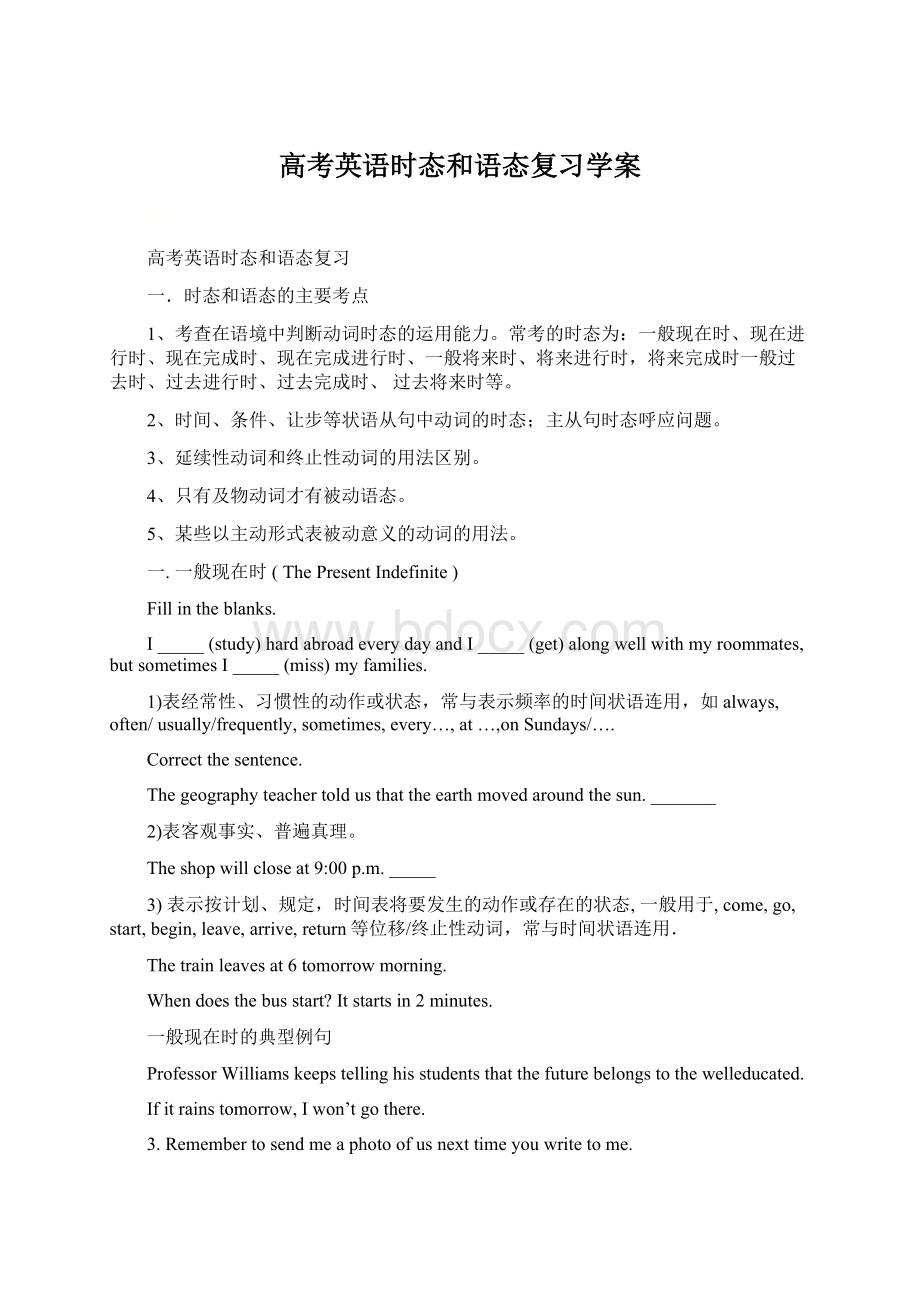高考英语时态和语态复习学案.docx
《高考英语时态和语态复习学案.docx》由会员分享,可在线阅读,更多相关《高考英语时态和语态复习学案.docx(11页珍藏版)》请在冰豆网上搜索。

高考英语时态和语态复习学案
高考英语时态和语态复习
一.时态和语态的主要考点
1、考查在语境中判断动词时态的运用能力。
常考的时态为:
一般现在时、现在进行时、现在完成时、现在完成进行时、一般将来时、将来进行时,将来完成时一般过去时、过去进行时、过去完成时、过去将来时等。
2、时间、条件、让步等状语从句中动词的时态;主从句时态呼应问题。
3、延续性动词和终止性动词的用法区别。
4、只有及物动词才有被动语态。
5、某些以主动形式表被动意义的动词的用法。
一.一般现在时(ThePresentIndefinite)
Fillintheblanks.
I_____(study)hardabroadeverydayandI_____(get)alongwellwithmyroommates,butsometimesI_____(miss)myfamilies.
1)表经常性、习惯性的动作或状态,常与表示频率的时间状语连用,如always,often/usually/frequently,sometimes,every…,at…,onSundays/….
Correctthesentence.
Thegeographyteachertoldusthattheearthmovedaroundthesun._______
2)表客观事实、普遍真理。
Theshopwillcloseat9:
00p.m._____
3)表示按计划、规定,时间表将要发生的动作或存在的状态,一般用于,come,go,start,begin,leave,arrive,return等位移/终止性动词,常与时间状语连用.
Thetrainleavesat6tomorrowmorning.
Whendoesthebusstart?
Itstartsin2minutes.
一般现在时的典型例句
ProfessorWilliamskeepstellinghisstudentsthatthefuturebelongstothewell�educated.
Ifitrainstomorrow,Iwon’tgothere.
3.Remembertosendmeaphotoofusnexttimeyouwritetome.
注意一些特殊的连词until,assoonas,themoment,immediately;aslongas,unless…
4.Therecomesthebus.汽车来了
Theregoesthebell.铃响了
二.现在进行时(ThePresentContinuousTense)
1)表示现在这个时刻(指说话时)正在发生的事情。
We___________(have)Englishclassnow.
2)表示目前这段时间内正在进行的动作,但说话时动作未必正在进行。
She___________(learn)pianounderMr.Smithatpresent.
Thegirlisalwaystalkingloudinpublic.
★进行时态与always,often/usually/frequently/constantly/allthetime等频度副词连用,表经常反复的行动或说话人赞叹或厌恶等感情色彩.
3)现在进行时用来表示按计划即将发生的
动作,多用于位移/终止性动词,如:
come,go,arrive,leave,stay,fly,takeoff.
I____________(leave)tomorrow.
_____you_______(stay)heretillnextweek?
4.现在进行时可以表示现在不断发展变化的事情。
It’slateAutumn.Theweatherisgettingcolderandcolder.
Correctthesentence.
AllthestudentshereisbelongingtoNo.1MiddleSchool.________
注意:
一般情况下,下面4类动词无进行时态:
(1)表心理状态、情感的动词:
like,love,hate,care,remember,believe,want,mind,agree,mean,need
(2)表存在的状态动词:
have,appear,exist,lie,remain,seem,belongto,dependon。
(3)瞬间动词:
begin/start,allow,accept,permit,promise,admit,complete。
(4)感官动词:
see,hear,notice,feel,smell,sound,taste,look。
三.现在完成时(ThepresentPerfectTense)
1).现在完成时表示从过去开始,一直延续到现在的动作或状态,通常用于延续性动词.
常与表一段时间的状语连用,如:
sofar,upto/tillnow,lately/recently,in/during/overthelast/past…,since…,for…等.
He__________(live)inGuiyangoverthepast6years.
2).说话前发生的一次或多次的动作,成为了一种经历,表示过去的某一动作对现在造成的影响或结果,常用的时间状语有:
just,already,yet,ever,never,once,twice,manytimes等.
We____________(finish)ourlunchalready.
______youever______(try)thismethod?
注意:
Ihavereceivedhisletterforamonth.()
Ihaven'treceivedhisletterforalmostamonth.()
非延续性/瞬间/终止性动词的否定形式可以与表示一段时间的状语连用于完成时态中,即动作不发生的状态是可以持续的。
如:
begin/start,find,see,marry,buy,borrow,return,die,get等。
练习:
1.Daniel__________(live)inBeijingsincehecametoChina.
2.Theboysaretired.They_______________(justplay)aballgame.
3.IwenttoEgyptin1986.Thenin2004Iwentthereagain.I__________(be)toEgypttwice.
since和for填空
since+______,用来说明动作起始时间
for+_______,用来说明动作延续时间。
Ihavelivedhere____atleasttwentyyears.
Ihavelivedhere____Iwasborn.
现在完成时典型句型
Mybrotherhasneverbeenabroadbefore.
Itis/hasbeenthreeyearssincehejoinedthearmy.
3.In(over)thepast10years,ourschoolhavechangedalot.
4.ItisthefirsttimethatIhavebeenthere.
5.Howardisoneofthemostfamousexplorerstheworldhaseverknown.
语法填空。
Welcometoourschool.I’dliketointroduceyouplansforourschool.Alotofwork1____________(do)inthepastfewyears.Thelibrary2________________(complete)andisreadyforuse.Butwestillhavetodomorework.
Tips:
固定的特殊句型:
1).Itis(hasbeen)+一段时间+since-clause.
2)This(That/It)isthefirst(second…)time+that-clause(现在完成时).
四.现在完成进行时
表示从过去开始的一个动作一直持续到现在,而且还在进行当中。
强调的是“从过去到现在一直在进行”。
其时间的判定由具体的时间段或上下句的语境决定。
Nowthatsheisoutofajob,Lucy____goingbacktoschool,butshehasn’tdecidedyet.
A.hadconsidered
B.hasbeenconsidering
C.considered
D.isgoingtoconsider
现在完成时和现在完成进行时的对比:
现在完成时和现在完成进行时都表示动作从过去开始,但现在完成时可表示事件或动作刚结束,而现在完成进行时则强调动作仍在继续。
LiJia__________(read)abookaboutStonehenge.(Shefinishedreadingthebook.)
LiJia________________(read)abookaboutStonehenge.(Sheisstillreadingthebook.)
五.一般过去时(TheSimplePastTense)
1.表过去发生了的动作或存在的状态。
常与表过去的时间连用。
如yesterday,last…,…ago,in…,then,justnow,theotherday等。
I__________(spend)mychildhoodhappilywithmyoldfriendsinthecountrysideseveralyearsago.
2.表示说话人始料未及的事情,要用一般过去时。
Ididn’tknowitwasyou.
Ineverexpectedyouwouldbringmeagift.
一般过去时的典型例句
Heoftensangwhenhewasaboy.
2.----Edward,youplaysowell.ButIdidn'tknowyouplayedthepiano.
3.—YouspeakverygoodFrench!
—Thanks.IstudiedFrenchinSichuanUniversityforfouryears.
4.Ithinkthefilmwasinteresting,butitisn’t.(T/F)
过去时和现在完成时
HehaslivedinBeijingforfouryears.
他在北京住了四年了。
(现在仍住那儿)
HelivedinBeijingforfouryears.
他曾在北京住了四年。
(现在不住那儿了)
1.HehaswrittentomefrequentlysinceIwasill.
2.HehaswrittentomefrequentlysinceIfellill.
句1从句谓语动词为状态动词
句2从句谓语动词为终止性动词
自从我病愈以来,他屡次给我写信。
自从我生病以来,他屡次给我写信。
Itisoneyearsincehebeganlivingthere.
Itisoneyearsincehelivedthere.
若since引导的状语从句的谓语动词是持续性动词或表示状态的动词的过去时时,则从句表示的时间是“从那持续动作结束或状态结束时算起”。
Itishalfamonthsincehewasastudent.
Ihaven’theardanynoisesinceIslept.
六.过去进行时Thepastcontinuoustense
规则1:
过去某一时刻或某一阶段内正在进行或频繁发生的动作.
(1)Duringthesummerof2010she___________(travel)inEurope.
规则2:
某一动作发生时另一动作正在发生,常用于由when/while,as引导的时间状语从句中.
(2)ImetDianawhileI____________(shop)thismorning.
★规则3:
过去进行时可以表示委婉语气.仅限于wonder,want,hope等,用于提出请求。
3)I____________(wonder)ifyoucouldgivemealift.
5.Asshe____thenewspaper,Granny____asleep.
A.read…wasfallingB.wasreading…fell
C.wasreading…wasfallingD.read…fell
七.过去完成时(haddone)
表示过去的过去,即过去某个时间或动作之前发生的事情或存在的状态。
表示过去某时间前已经发生的动作或情况(过去的过去)
IhadstayedinBeijingforthreeyearsby2017.
当我去到机场时,他已经走了.
WhenIgottotheairport,
_____________________.
他说他之前读过这本书.
Hesaid______________________.
Bytheendoflastmonthwehaveviewedscoresofwebsites.(改错)____________
7.Thelittlegirl____herheartoutbecauseshe____hertoybearandbelievedshewasn’tevergoingtofindit.
A.hadcried,lostB.cried,hadlost
C.hascried,haslostD.cries,haslost
8.—Hurryup!
AliceandSuearewaitingforyouattheschoolgate.
—Oh!
Ithoughtthey______withoutme.
A.went B.aregoing C.havegone D.hadgone
规则2:
表示未曾实现的愿望、打算、意图、承诺等。
常用hadhoped/planned/meant/intended/thought/wanted/expected(+that…/todo)或用上述动词的过去式接不定式完成式表示,即:
hoped/planned…+to(havedone)。
Wearrivedearlierthanwe_______________(expect).
七.过去完成进行时Thepastperfectcontinuoustense
结构:
hadbeen+v-ing
表示过去某个时间或动作之前一直进行的事情。
Theyhadbeenlearningabroadfor6yearstilllastmonth.
Bob__________________(serve)inthearmybeforehebecameajournalist.
八.一般(过去)将来时(TheSimple/PastFutureTense)
1.表示(过去)将来/要发生的动作或存在的状态。
will/would+v.
Theemployer_________________(interview)alltheemployeesnextWednesday.
.表(过去)计划、安排、打算、预测将要做某事。
am/is/are(was/were)goingto+v.
ProfessorSmith____________________(lecture)onmoderndramatonight.
Thedarkcloudsis/wasgathering.There________________(be)astorm.
3.am/is/are(was/were)todosth.表按计划、安排(过去)即将发生的动作,还可表示吩咐、命令、禁止、可能性等.
Theywillsay/saidgoodbye,littleknowingthey____________________never___________(meet)again.
4.am/is/are(was/were)abouttodosth.(when…)“正/就要做某事”(不与具体时间连用)
He____________________(apologize)tomewhensomeonegaveasuddenblowonhisshoulder.
状语从句中的时态:
含有状语从句的主从复合句时态主将从现。
1.---CanIjointheclub,Dad?
---Youcanwhenyou_____abitolder.
A.getB.willget
C.aregettingD.willhavegot
2.Insuchdryweather,theflowerswillhavetobewateredifthey_____.
A.havesurvivedB.aretosurvive
C.wouldsurviveD.willsurvive
3.TheWTOcan’tliveuptoitsnameunlessitwillincludeacountrythatishometoone-fifthofmankind.________
4.Japanwillneverberecovered/restoredevenifitwillreturnDiaoyuIslandstoChina._______
5.Theharderyouwillstudy,thebetterresultsyouwillget._________
其它主从复合句中时态的呼应
主句为一般现在时,(宾语)从句可为任何时态;主句为过去时,(宾语)从句跟相应的过去时态。
1.Idon’tthink___________________________.
他(将)通过(了)驾驶测试。
2.TheWhitesexpected___________________________Tonny能出国深造。
在祈使句+and/or/…+陈述句句型中,陈述句中只能用will/情态动词+动词原形。
1.LeaveitwithmeandI_____whatIcando.
A.seeB.seeingC.amseeingD.willsee
2.Pleasegivebloodifyoucanorsomelives______.
A.scareawayB.couldscareaway
C.scaredawayD.toscareaway
Remember下列句型
Itis(hasbeen)/was+一段时间+since…(did/haddone)This(That/It)is/wasthefirst(second…)timethat…+have(has)done/haddone
This(That/It)is/wastheonly…+that…+have(has)done/haddone
This(That/It)is/wasthebest/finest/mostinteresting…+that…+have(has)done/haddone
Hardly/scarcely…过去完成时+when…一般过去时
Nosooner…过去完成时+than…一般过去时
动词时态语态一览表(以do为例)
时态主动被动
一般现在时do/doesam/is/aredone
现在进行时am/is/aredoingwas/werebeingdone
现在完成时have/hasdonehave/hasbeendone
一般过去时didwas/weredone
过去进行时was/weredoingwas/werebeingdone
过去完成时haddonehadbeendone
一般将来时willdowillbedone
将来完成时willhavedonewillhavebeendone
及物动词(vt.)有被动语态,不及物动词(vi.)或短语无被动语态.
比较:
rise是不及物动词;raise是及物动词。
判断对错
Thepricehasbeenrisen.()
Thepricehasrisen.()
Thepricehasraised. ()
Thepricehasbeenraised.()
Theaccidentwashappenedlastweek.()
Theaccidenthappenedlastweek.()
一.主动和被动
Get/have/fi